Search results for 'ITS 320'
-

ITS320 Module 1 Option 1 Create a Python Application that outputs mouse
Regular Price: $10.00
Special Price $8.00
ITS320 Module 1 Option 1 Create a Python Application that outputs mouse
Option #1: Create a Python Application
Write a Python Program that outputs this mouse:
(\-.
/ _`>
_) / _)=
( / _/
`-.__(___)_
Assignment Instructions
1. Install Python3 on your computer if you do not have it already installed it. You can download it from https://www.python.org/downloads/release/python-362/.
2. Make sure you check the box to include the Python executable in your environment path.
3. Edit your Python program using your choice of editor such as Notepad, Notepad++, or Idle. Idle is a simple Python interactive development environment that installed with your Python package.
4. Save your Python code using the file name ITS320_CTA1_Option1.py.
5. Execute your Python code in command prompt as python ITS320_CTA1_Option1.Assignment Deliverables
Learn More
• Submit the text file named ITS320_CTA1_Option1.py that contains your Python code into the Module 1 drop box -

ITS320 Module 1 Option 2 Create a Python Application that read two integers and print two lines
Regular Price: $10.00
Special Price $8.00
ITS320 Module 1 Option 2 Create a Python Application that read two integers and print two lines
Option #2: Create a Python Application
Read two integers and print two lines. The first line should contain integer division, //, the second line should contain float division, /, and the third line should contain modulo division, %. You do not need to perform any rounding or formatting operations.
Input Format The first line contains the first integer. The second line contains the second integer.
Output Format Print the three lines as described above.Sample Input
4
3Sample Output
1
1.3333333333333333
1Assignment Instructions
1. Install Python3 on your computer if you don’t have it already installed. Make sure you check the box to include the Python executable in your environment path.
2. Edit your Python program using your choice of editor such as Notepad, Notepad++, or Idle. Idle is a simple Python interactive development environment that installed with your Python package.
3. Save your Python code in a file name ITS320_CTA1_Option2.py.
4. Execute your Python code in command prompt as python ITS320_CTA1_Option2.Assignment Deliverables
Learn More
Submit the text file named ITS320_CTA1_Option2.py that contains your Python code into the Module 1 drop box. -
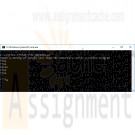
ITS320 Module 2 Option 1 Creating a Python Application for string validation
Regular Price: $10.00
Special Price $8.00
ITS320 Module 2 Option 1 Creating a Python Application for string validation
Option #1: Creating a Python Application
Python has built-in string validation methods for basic data. It can check if a string is composed of alphabetical characters, alphanumeric characters, digits, etc.
str.isalnum() This method checks if all the characters of a string are alphanumeric (a-z, A-Z and 0-9).
>>> print 'ab123'.isalnum()
True
>>> print 'ab123#'.isalnum()
False
str.isalpha() This method checks if all the characters of a string are alphabetical (a-z and A-Z).
>>> print 'abcD'.isalpha()
True
>>> print 'abcd1'.isalpha()
False
str.isdigit() This method checks if all the characters of a string are digits (0-9).
>>> print '1234'.isdigit()
True
>>> print '123edsd'.isdigit()
False
str.islower() This method checks if all the characters of a string are lowercase characters (a-z).
>>> print 'abcd123#'.islower()
True
>>> print 'Abcd123#'.islower()
FalseSAMPLE
str.isupper() This method checks if all the characters of a string are uppercase characters (A-Z).
>>> print 'ABCD123#'.isupper()
True
>>> print 'Abcd123#'.isupper()
FalseAssignment Instructions:
Write a Python program that performs the following tasks:
1. Read from the console an arbitrary string S of length less than 50 characters.
2. In the first output line, print True if S has any alphanumeric characters. Otherwise, print False.
3. In the second line, print True if S has any alphabetical characters. Otherwise, print False.
4. In the third line, print True if S has any digits. Otherwise, print False.
5. In the fourth line, print True if S has any lowercase characters. Otherwise, print False.
6. In the fifth line, print True if S has any uppercase characters. Otherwise, print False.
7. Develop Python code that implements the program requirements.Assignment Deliverables:
Learn More
• Submit a text file containing your Python code into the Module 2 drop box. Name your file ITS320_CTA2_Option1.py -
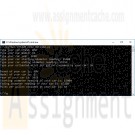
ITS320 Module 2 Option 2 Creating a Python Application using dictionary
Regular Price: $10.00
Special Price $8.00
ITS320 Module 2 Option 2 Creating a Python Application using dictionary
Option #2: Creating a Python Application
Assignment Instructions
Develop a Python application that incorporates using appropriate data types and provides program output in a logical manner. Your program should prompt a user to enter a car brand, model, year, starting odometer reading, an ending odometer reading, and the estimated miles per gallon consumed by the vehicle. Store your data in a dictionary and print out the contents of the dictionary.Assignment Submission Instructions:
Learn More
Submit a text file containing your Python code into the Module 2 drop box. Name your file ITS320_CTA2_Option2.py. -
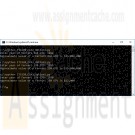
ITS320 Module 3 Option 1 Creating a Program to Calculate the Value of a Ferrari
Regular Price: $10.00
Special Price $8.00
ITS320 Module 3 Option 1 Creating a Program to Calculate the Value of a Ferrari
Option #1: Creating a Program to Calculate the Value of a Ferrari
Assignment Instructions
Implement a program that reads in a year and outputs the approximate value of a Ferrari 250 GTO in that year. Use the following table that describes the estimated value of a GTO at different times since 1962.
Year Value
1962-1964 $18,500
1965-1968 $6,000
1969-1971 $12,000
1972-1975 $48,000
1976-1980 $200,000
1981-1985 $650,000
1986-2012 $35,000,000
2013-2014 $52,000,000
(Source: Programming in Python 3 with Zylabs, Chapter 4, Participation Activity 4.3.5)Assignment Submission Instructions
Learn More
Submit a text file containing your Python code into the Module 3 drop box. Name your file ITS320_CTA3_Option1.py. -
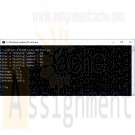
ITS320 Module 4 Option 1 Repetition Control Structure – Five Floating Point Numbers
Regular Price: $10.00
Special Price $8.00
ITS320 Module 4 Option 1 Repetition Control Structure – Five Floating Point Numbers
Option #1: Repetition Control Structure – Five Floating Point Numbers
Assignment Instructions
Write a program that utilizes a loop to read a set of five floating-point values from user input. Ask the user to enter the values, then print the following data:
• Total
• Average
• Maximum
• Minimum
• Interest at 20% for each original value entered by the user.
• Use the formula: Interest_Value = Original_value + Original_value*0.2Assignment Submission Instructions
Learn More
• Submit a text file containing your Python code into the Module 4 drop box. Name your file ITS320_CTA4_Option1.py. -
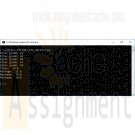
ITS320 Module 4 Option 2 Repetition Control Structure – Grade Statistics
Regular Price: $10.00
Special Price $8.00
ITS320 Module 4 Option 2 Repetition Control Structure – Grade Statistics
Option #2: Repetition Control Structure – Grade Statistics
Assignment Instructions
1. Write a program that will provide important statistics for the grades in a class. The program will utilize a loop to read five floating-point grades from user input.
2. Ask the user to enter the values, then print the following data:
• Average
• Maximum
• MinimumAssignment Submission Instructions
Learn More
• Submit a text file containing your Python code into the Module 4 drop box. Name your file ITS320_CTA4_Option2.py -
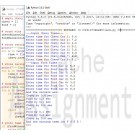
CIS115 Week 5 Lab Race Time Sorting in Python
Regular Price: $12.00
Special Price $10.00
CIS115 Week 5 Lab Race Time Sorting in Python
CIS115 Week 5 Lab Overview
Title of Lab: Race Time Sorting in Python
Summary
Store the times into arrays called Chevy[ ] and Ford[ ]. Then list the winner of each pair, giving the number of seconds the winner won by. At the end declare which team won based on which team had the most wins.Deliverables
• A source code Python file.
• A Word document containing both source code and the screen print of the program outputs.Lab Steps
There are eight cars in each team called Chevy and Ford. One car from each team races its opponent on the drag strip. Read in the racing times for the eight Chevy cars and then read in the times for the eight Ford cars.Sample Match:
---Input Chevy Times---
Enter time for Chevy Car 1: 5.4
Enter time for Chevy Car 2: 7.2
Enter time for Chevy Car 3: 4.0
Enter time for Chevy Car 4: 9.1
Enter time for Chevy Car 5: 5.8
Enter time for Chevy Car 6: 3.9
Enter time for Chevy Car 7: 6.2
Enter time for Chevy Car 8: 8.1
---Input Ford Times---
Enter time for Ford Car 1: 5.8
Enter time for Ford Car 2: 6.9
Enter time for Ford Car 3: 3.9
Enter time for Ford Car 4: 9.2
Enter time for Ford Car 5: 5.8
Enter time for Ford Car 6: 3.8
Enter time for Ford Car 7: 6.0
Enter time for Ford Car 8: 8.5
And the winners are:
Chevy by 0.4 sec
Ford by 0.3 sec
Ford by 0.1 sec
Chevy by 0.1 sec
Tie!
Ford by 0.1 sec
Ford by 0.2 sec
Chevy by 0.4 sec
And the winning team is: F O R D !Specifications:
Learn More
• Accept the racing times for each of the Chevy cars into the array Chevy[ ].
• Accept the racing times for each of the Ford cars into the array Ford[ ].
• Then declare the wining car for each race, giving the winning time in seconds.
• If the times are identical, then declare the race was a tie.
• Finally, declare which team won the match, assuming a tie is possible. -

CYB/130 Week 4 Python LAB 5.18: Miles to track laps
Regular Price: $8.00
Special Price $3.00
CYB/130 Week 4 Python LAB 5.18: Miles to track laps
One lap around a standard high-school running track is exactly 0.25 miles. Write the function miles_to_laps() that takes a number of miles as an argument and returns the number of laps. Complete the program to output the number of laps.Output each floating-point value with two digits after the decimal point, which can be achieved as follows:
print('{:.2f}'.format(your_value))Ex: If the input is:
1.5
the output is:
6.00Ex: If the input is:
2.2
the output is:
8.80Your program must define and call the following function:
Learn More
def miles_to_laps(user_miles) -

CYB/130 Week 4 Python LAB 5.19: Driving costs - functions
Regular Price: $8.00
Special Price $3.00
CYB/130 Week 4 Python LAB 5.19: Driving costs - functions
Driving is expensive. Write a program with a car's miles/gallon and gas dollars/gallon (both floats) as input, and output the gas cost for 10 miles, 50 miles, and 400 miles.Output each floating-point value with two digits after the decimal point, which can be achieved as follows:
print('{:.2f}'.format(your_value))Ex: If the input is:
20.0
3.1599
the output is:
1.58
7.90
63.20Your program must define and call the following driving_cost() function. Given input parameters driven_miles, miles_per_gallon, and dollars_per_gallon, the function returns the dollar cost to drive those miles.
Ex: If the function is called with:
50 20.0 3.1599
the function returns:
7.89975def driving_cost(driven_miles, miles_per_gallon, dollars_per_gallon)
Learn More
Your program should call the function three times to determine the gas cost for 10 miles, 50 miles, and 400 miles.
Note: This is a lab from a previous chapter that now requires the use of a function.




